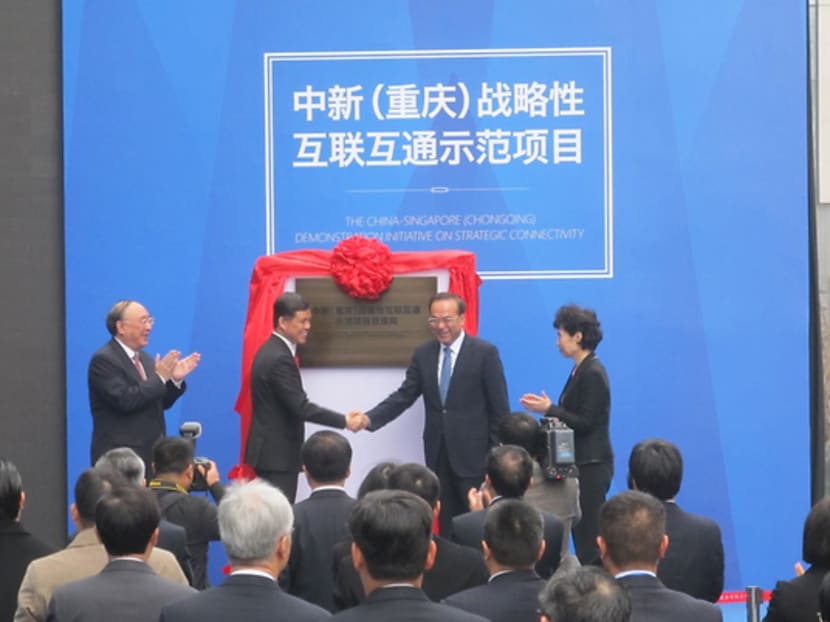One Belt, One Road project will benefit Singapore, but challenges could arise: Analysts
SINGAPORE — While China’s One Belt, One Road (OBOR) initiative will provide significant opportunities for Singapore, the city-state should also be mindful of the various challenges that the large-scale project could surface, observers say.

Singapore and China deepened their cooperation on Jan 8, 2016 with the opening of an Administrative Bureau Office in Chongqing and a project signing to flag off their third government-to-government project. Photo: CNA
SINGAPORE — While China’s One Belt, One Road (OBOR) initiative will provide significant opportunities for Singapore, the city-state should also be mindful of the various challenges that the large-scale project could surface, observers say.
OBOR, the brainchild of Chinese President Xi Jinping, is a massive bankrolled infrastructure programme linking China with Africa, Asia and Europe through a network of ports, railways, roads and industrial parks. OBOR encompasses over 60 countries representing 60 per cent of the global population and about one-third of the world’s gross domestic product. The China Development Bank alone has earmarked US$890 billion (S$1.24 trillion) for some 900 projects.
Veteran diplomat Ong Keng Yong told TODAY that Singapore stands to benefit from OBOR given that the republic is a key commercial node in the region.
“We should take the positive approach (towards OBOR),” said Mr Ong, who is the executive deputy chairman at the S Rajaratnam School of International Studies and a former secretary-general for the Association of South-east Asian Nations.
“Any project which involves substantial investment in terms of resources deployed will benefit the economy and marketplace. This means some benefits will come to Singapore because we are an important business, financial and transportation hub,” he added.
“If our companies and talented individuals are able to demonstrate their capabilities to help execute the projects in the OBOR initiative, we can get some of the action coming out of this massive endeavour.”
Professor Chung Chi-Nien of the National University of Singapore (NUS) Business School said that OBOR offers “bountiful opportunities” for Singaporean firms.
“Business services such as financing and legal practices may benefit in the early stage of this project, while the sectors of construction and trading of raw materials will follow,” he explained. “After the project is finished, there will be other opportunities for businesses such as real estate development, logistics, and e-commerce.”
China expert Lim Tai Wei Lim said that Singapore’s involvement in the Chongqing Connectivity Initiative (CCI) could allow the republic to benefit from the Belt and Road programme.
The CCI is the third government-to-government cooperation project after the Suzhou Industrial Park and the Tianjin Eco-city.
“Chongqing, which is in south-west China, is a gateway between China and Central Asia. If the CCI is successful, Singapore can have a leg in both maritime as well as overland routes of OBOR,” explained Dr Lim, who is an adjunct research fellow with NUS’ East Asian Institute.
“In this sense, the OBOR initiative is the right platform for Singapore to conduct its economic diplomacy with China. It represents the top Chinese leadership’s most important economic legacy and an opportunity for Singapore to benefit economically from meaningful projects that can enhance regional connectivity.”
National Development Minister Lawrence Wong, who was in Beijing to attend the recently concluded two-day OBOR forum, told reporters on Tuesday (May 16) that Singapore can contribute towards financing projects, as well as provide expertise in infrastructure planning.
He also saw OBOR as a good platform for regional integration, noting that “it will provide a tremendous boost to trade, connectivity and infrastructure development”.
But Mr Wong noted that “we should be aware that it can present competition”.
“With the Belt and Road (initiative), new infrastructure will be built all around us...Trade routes will be adjusted as these new roads and ports get built and developed,” he added.
Dr Lim agreed that the OBOR could be a double-edged sword for Singapore.
“Singapore’s role as a trans-shipment hub could be enhanced by increased trade arising from the better connectivity brought about by the Belt and Road scheme,” he said.
“However, regional nations are also improving their infrastructure and competitiveness to better integrate themselves into the OBOR edifice, and this invariably means that they would become more competitive for a share of the regional economic pie.”
To stay ahead, Dr Lim believed that “Singapore has to constantly upgrade its infrastructure, incorporate cutting-edge technologies, and implement skills training/retraining programmes in order to be competitive.”
Singaporean companies that plan to do business in the key nodes of the OBOR, especially those in Central and West Asia, should also note the political risks they could face, Prof Chung of NUS said.
“Some countries are prone to military coups where foreign assets and investments have been confiscated after the armed forces took power. There are also countries where projects involving China and ethnic Chinese are viewed with great suspicion,” he explained.
In addition, terrorism and insurgency are endemic in some of the key OBOR nodes.
Last week, 10 Pakistani workers were gunned down while working on link roads to connect outlying towns to the country’s US$57-billion Belt and Road initiative. This incident took place only 20 km from the emerging port city of Gwadar in Baluchistan province that forms the southern hub of the China-Pakistan Economic Corridor.
To mitigate risks like these, Prof Chung advised Singaporean firms involved in the Belt and Road initiative to enter into joint ventures. WITH AGENCIES






